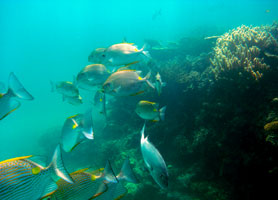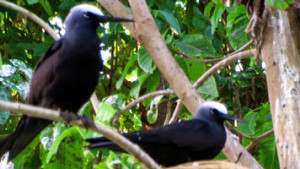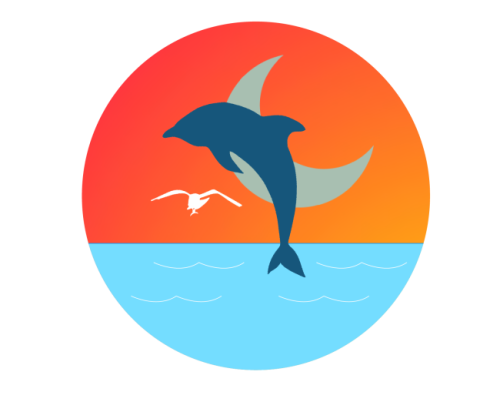Heron Island is the ideal island for anyone looking to disconnect from the rest of the world and just relax and connect with nature.
The island is far more exclusive than many other islands off the coast of Australia.

Clear water
It doesn’t allow day trippers and none of the 109 rooms at the Great Barrier Reef Resort (the accommodation on the island) have television nor mobile phone reception.
If you are a visitor to Heron Island, you will have no choice but to sit back, relax, and take in the island, or jump right in and experience all the island has to offer.
The island is situated right off the the Great Barrier Reef, which means that visitors can literally snorkel on the reef right off the island.
It is also a popular spot for scuba divers, who return time and again to experience all of the 20 dive sites located nearby.
Given that the island is so well suited to diving, Heron Island offers a variety of services associated with diving, including equipment rental, three fully-equipped dive boats with room for up to 20 divers each, as well as other information, such as marine life identification books, that might be helpful for a dive. Snorkeling and scuba  diving two of the primary attractions on Heron Island.
diving two of the primary attractions on Heron Island.

Lion Fish
The nature is also a major attraction at Heron Island.
The island is a protected habitat for a variety of wildlife.
Year-round, visitors to Heron Island can find a diverse range of wildlife inhabiting the island. January is the peak breeding season for sea birds.
Up to 100,000 birds can be on the island, with Black Noddy Terns, Wedgetailed Shearwater, and Eastern Reef Egrets particularly common.
Also at this time, female turtles are laying eggs and turtle hatchlings can be seen making their way to the sea. By May, the last of the young turtles will be leaving their nests.
The young Wedgetailed Shearwaters are in the midst of learning to fly at this point so that they can leave the island by the end of the month.
In June, Humpback Whales begin their northern migration. During this time, whales can be seen around the island, with the jetty being a particularly good spot for whale watching.
By September, whale activity is at its peak. Humpbacks are breaching regularly as they begin to head south to the Antarctic with their calves.
Also in September, the northern migratory birds, such as the Ruddy Turnstone and the Easter Golden  Plover, return to the island.
Plover, return to the island.
In October, a variety of other birds return to the island from their northern migration.
Additionally, turtles begin to mate in the surrounding waters. In November coral spawning begins, as does turtle egg laying.
By December, the island is awash in around 100,000 birds again and turtle hatchlings being emerging. As you can see, it doesn’t matter when you visit, you will be able to take in, and enjoy a wide array of wildlife on Heron Island.
Accommodation – Heron Island
The only accommodation on Heron Island is the Great Barrier Reef Resort. The resort boasts 109 rooms that range in location and quality.
However, all accommodation at the resort includes, a balcony or terrace, ceiling fans, a fridge, tea and coffee making facilities, beach towels, a clock radio, ironing facilities, extra pillows and blankets, en-suite bathroom with hairdryers, and an  umbrella.
umbrella.
It also boasts a restaurant and a swimming pool adjoined to a bar.
How to Get There – Heron Island
The island is located 89km off the coast of Queensland. There is a choice of transfer options to the island from Gladstone, which you can reach by plane from Brisbane and Sydney.
From Gladstone, visitors can either take a boat, for $60 AUD, or a seaplane, for $338 AUD, to the island.
 TravellerHints!
TravellerHints! 


